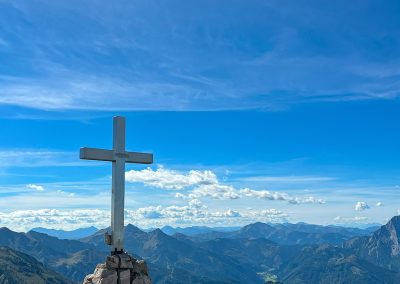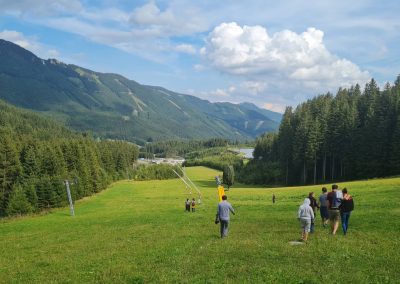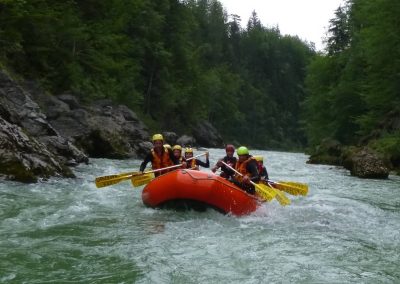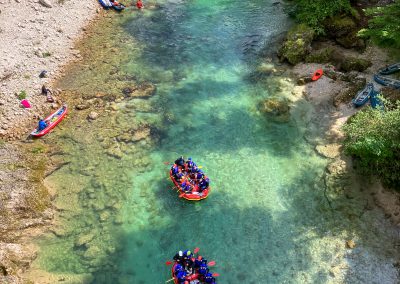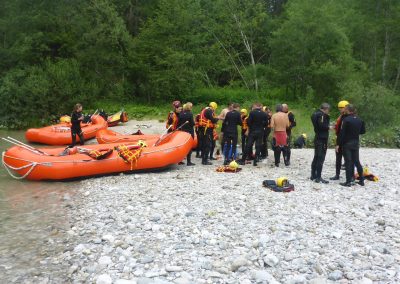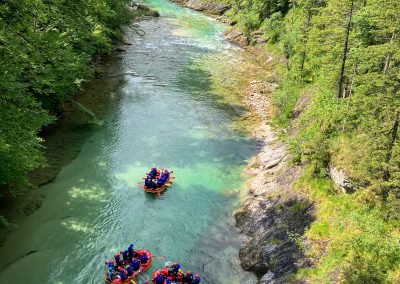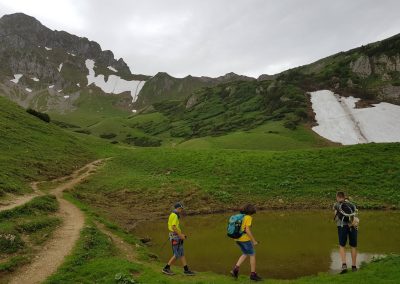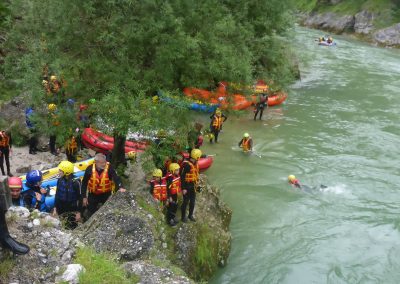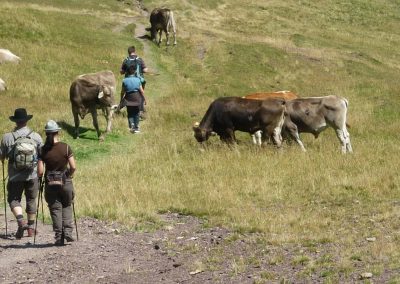Program options:
Via Ferrata, Klettersteig
What does this initially odd-sounding term mean?
„A Via Ferrata (jelentése olaszul: vas út; németül: klettersteig) olyan hegyi út, amelyen előzetesen felszerelt létrák, lépcsők, hidak és fémkábelek segítik az előrehaladást. A Via Ferrata túrázás is némi gyakorlatot, fizikai állóképességet és megfelelő felszerelést igényel. Mivel ezek az utak gyakran nagy magasságokban vezetnek, a tériszony leküzdése az ilyen jellegű túrák elengedhetetlen része." (Forrás: Wikipedia)
Tulajdonképpen egy extrém sport, mely több mint száz éves múltra tekint vissza, a magashegyi túrázás és a sziklamászás igazi öszvér - mára már teljesen önállóvá vált - ágazata. Ennek köszönhetően azonban biztonságos és felejthetetlen élményt nyújt annak, aki kipróbálja. Elsősorban a magashegyek szerelmesei játszanak el először a gondolattal, hogy kipróbálják ezt a sportot. A túrázástól eltérően ennek van némi felszerelés vonzata, ami azonban nem mérhető mondjuk egy alpinista, vagy egy raftingos cucc összetettségéhez és költségeihez.
Essentially, classic ferrata routes are old, well-established climbing paths constructed by professional mountaineers. Their aim was to allow people, assuming a certain level of climbing knowledge, to marvel at unique cultural and natural attractions without the need for extensive gear or advanced rock climbing skills typically required to access such areas without such protection.
Difficulty levels
The classification follows an A-E scale, which corresponds to the UIAA rock climbing difficulty grades without the use of safety ropes, in a certain order.
A,B - Játék fokozat, a legnagyobb nehézséget a folytonos akasztgatás jelenti
C - Itt kezdődnek az élvezetek
D - Ez a fokozat már komolyabb izommunkát igényel, de egyszerű halandók számára teljesíthető egy-egy ilyen szakasz
E - Jó kondi kell hozzá, akkor vállaljuk be, ha már kipróbáltuk magunkat D-n.
Az egész útvonalra általában a legnehezebb szakasznak megfelelő betűt nyomják rá. Pl. a Haidsteig D-re van értékelve, noha egyetlen kb. 15 méteres ilyen nehézségű szakasza van. Érdemes indulás előtt tájékozódni, mert egy 150 méteres vagy egy 15 méteres D-s résszel bíró út nem egyre megy. A komolyabb ferráták kiépítésénél általában az elejére tesznek egy nehéz részt, ahol "elhullik a férgese", és nem okoz feljebb közlekedési dugót.
(Source: http://lud.trek.tripod.com/vegyes/viaferrata.htm)
Nearby, you can access the following routes among the recently built modern klettersteigs in the area:
A fekvő pap - "Eisenerzer Klettersteig" Pfaffenstein
http://www.hegyvilag.hu/wp-content/uploads/2009/02/eisenerzer-map.pdf
A Császár maga - "Kaiser Franz Josef Klettersteig"
http://www.turatars.com/blog/view/id_594/title_A-Csaszar-maga-Kaiser-Franz-Joseph
Mintha két túra lenne - "Rosslochhöhlen Klettersteig"
https://www.steiermark.com/de/Urlaub-planen/Tourenportal/Rosslochhoehlen-Klettersteig_tour_1143811
Pajzs - "Kaiserschild Klettersteig"
http://www.hegyvilag.hu/?p=2023
Useful links:
http://www.klettersteige-eisenerz.at/klettersteige_wandern.htm
Cycling tours
Austria, familiar for its ski slopes, boasts a professional cycling infrastructure with well-developed, signposted cycling routes. In Styria province alone, there are thousands(!) of kilometers of bike paths. It's not a coincidence, as local active skiers also hop on their bikes during the spring, summer, and autumn months, keeping their skiing muscles in top condition.
It can be said that Austria is a true cyclist's paradise, and the mountains surrounding Präbichl offer numerous designated cycling routes. Just 200 meters from the guesthouse lies one of the mountain bike trails, stretching 14 km with a 389 m elevation gain, classified as moderately difficult. There are many other cycling routes in the area suitable for beginners as well as seasoned cyclists.
https://hu.bergfex.com/sommer/praebichl/touren/bike/
Among the countless options, everyone can find enjoyable routes, and for the most determined, there may be tougher rides than the Mátra marathon.
The pyramid-shaped open-pit mine, located 2 km from the guesthouse, is a paradise for professional and amateur mountain bike racers and motocross enthusiasts in the summer, hosting numerous cycling competitions.
Paragliding
"Ha egyszer megérzed a repülés ízét, utána a földön járva, szemeiddel mindig az égboltot pásztázod és visszavágysz, oda ahová már tartozol, a fellegek közé..." Leonardo Da Vinci
For the Hungarian sports and nature enthusiasts hoping to find the sensation of freedom in paragliding, neither the erratic legislation nor the various conditions (human, societal, communal, financial, commercial, etc.) of this extreme sport in the country have dampened their spirits. They can already sense the physical reality of the Hungarian lowland.
This can be viewed from a positive perspective because based on personal experience, I can confidently say that the average Hungarian paraglider is significantly more skilled in takeoff techniques and has better physical endurance than their counterparts from mountainous countries, making both factors undeniable strengths of this domestic sport.
Furthermore, locations like Nyikom, Eger, and Bérhegy offer suitable sporting opportunities. Moreover, squabbling with local conservationists in the Pilis or Csobáncon is actually a logical continuation of the Hungarian bandit life from the early 20th century.
Then, the first Hungarian magazine, the "Ernyősök," appears, and we read bombastic reports about paragliding - exclusively (!) abroad... And our big shots and aspiring big shots start flocking to Austria and Slovakia one after another. So, there must be something that attracts the boys and girls raised on the tow rope beyond the edge of the cliff!
As an introduction (and to kick off the debate), here are five reasons why and for whom it's worth going to Austria for paragliding:
- Ausztriában a siklóernyős elismert, megbecsült és szívesen látott vendég, természetbarát és sportoló. Nem meg- és eltűrt ön- és közveszélyes őrült, természetromboló és köztörvényes alapon üldözendő törvényen kívüli birtokháborító. Mondhatnánk úgy is, hogy ott a siklóernyőzés a tömegsport és egészségkultúra része, de nem mondjuk, mert ez olyan kultúr szövegnek hangzik, és a siklóernyős, ugye, szabad ember.
- A Polster is a well-maintained lift operates in winter and summer, awaiting enthusiasts of this aerial sport. Detailed and reliable flight meteorology is available for free on the "austrocontrol" internet service, updated daily (even on weekends!) until 8 am.
- Kiváló infrastruktúra és jó megközelíthetőség – az Alpenrose-tól 200 méterre van az út másik oldalán a felvonó a starthelyhez, így családi kirándulás célpontjaként is kiváló, síelés, korcsolyázás, túrázás, fürdés alternatíváját kívánva a siklóernyőzés látványától is borzadó hozzátartozók részére.
- A földrajzi adottságok miatt a 300 métertől felfelé terjedő magasságkülönbségeket garantálnak, azaz ott kezdődnek, ahol a Pilis véget ért. Elevation difference: 680 meters.

